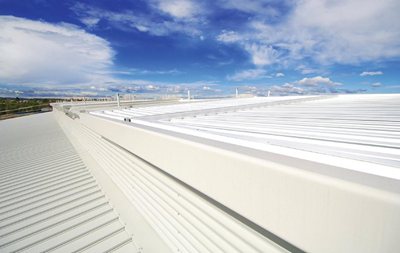The roof is where the sun touches a building and how it performs at this time is a determining factor in the amount of electricity needed to cool the building.
However, its full potential is often not recognised or captured. In addition to weather proofing, a roof can improve the energy efficiency of buildings in hot weather and at times of peak energy load; reduce electricity bills for cooling, and assist communities in coping with heatwaves and extreme summer temperatures.
Design, technology and building material choice combine to make the roof a high performance and active part of a responsive building that optimises the interface between the environment, the building, the living and working spaces and the occupants. In simple terms, all roofs are not equal.
The roof is where the sun touches a building and how it performs at this time is a determining factor in the amount of electricity needed to cool the building. This interface between sun and roof is even more critical in hot summer months and heat waves when peak electricity demand can result in electricity rationing or blackouts. The term used for this type of high performance roof is a 'cool roof', as it minimises the amount of heat generated when the sun hits its surface and maximises the dispersement of heat when the sun sets or the weather changes, known as high emittance. Optimising these two attributes in a roof can help reduce the amount of energy needed to cool a building, benefiting the occupant with lower electricity bills and the environment with lower resource usage and carbon emissions. The best measure of a roofing material's performance is called the Solar Reflective Index (SRI). The higher the SRI, the better the performance.
As a general rule, light coloured materials reflect more sunlight and absorb less energy as heat than dark coloured materials, and low thermal mass materials emit heat quicker than high thermal mass materials. A recent NASA survey of New York City's rooftops identified that dark, heat-absorbing rooftops were up to 5.6 degrees C hotter than white rooftops. It's important to remember that colour is not the only factor. Advanced coating technologies now used on some roofing materials improve solar performance of colours and materials above the general rule. The best way to identify the highest performing materials is to look for the ones with the highest SRI, or if that is not available the highest reflectivity level (lowest absorption level).

As cities expand, urban planners and developers need to be conscious of the impact that infrastructure has on the local environment and urban micro climate. In the past, cities have been developed without full appreciation of the role that design and material choice plays in determining local climatic conditions. One example is the removal of large areas of vegetation, which form part of nature's cooling system and replacing it with low-reflective, high mass, water resistant, impervious surfaces that absorb a high percentage of sunlight as heat.
These design and material choices have resulted in a phenomenon called the Urban Heat Island (UHI) effect which results in cities and urban areas being significantly warmer than rural or undeveloped areas that surround them.
The development of UHIs is likely to be a significant climate adaptation issue for Australia given the potential for more frequent heat waves. Alarmingly, heatwaves cause more deaths than natural disasters such as bushfires and floods. By increasing the reflectivity of buildings, cool roofs are certainly part of the solution.
The cool roof movement is a global movement which had its genesis in the USA. A large amount of research has been undertaken in the USA and Australian universities are now undertaking research from an Australian climate perspective. In Australia, the recent Federal Government report on the State of Australian Cities highlighted UHI's and the role of cool roofs in managing the UHI effect. The City of Melbourne has also recently started to promote the benefits of cool white roofs.
The Global Cool Cities Alliance (GCCA) is also great place to obtain more information on UHI's and cool roofs. The GCCA works towards advancing policies and actions that increase the solar reflectance of buildings and pavements as a low cost way to promote cool buildings, cool cities, and therefore a cooler world - which we should all be working work towards.
Richard Rowe is a Sustainability Manager focussing on BlueScope Steel's Australian markets. He joined BlueScope Steel in 2001 after working in a number of industries including Petroleum and Logistics. After a career focused on commercial roles, Rowe has transitioned to sustainability where he has undertaken a number of projects including sustainability within the built environment and carbon pricing.

